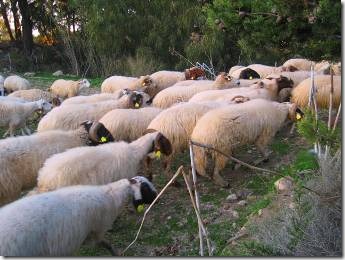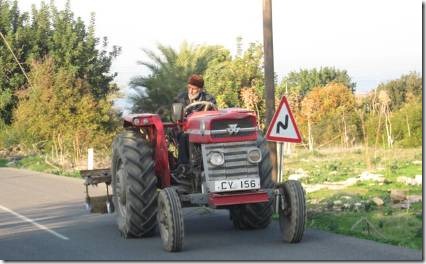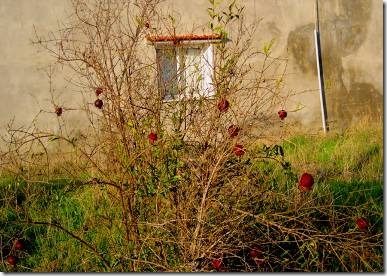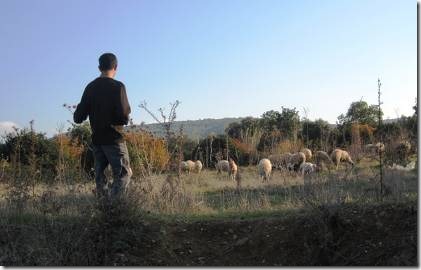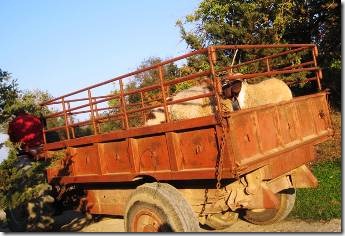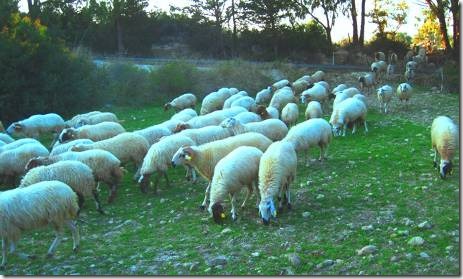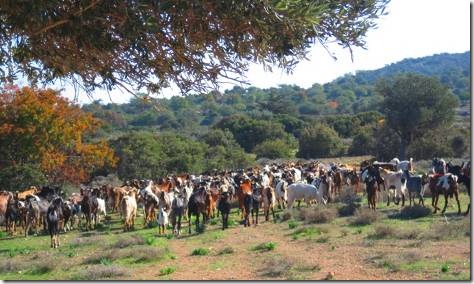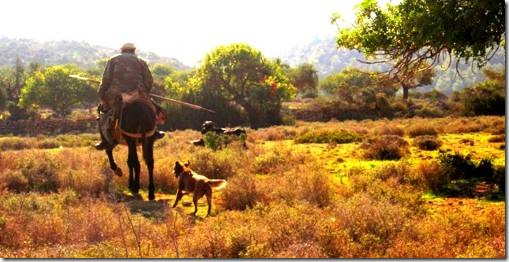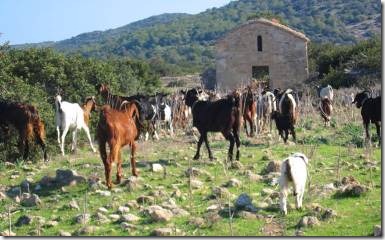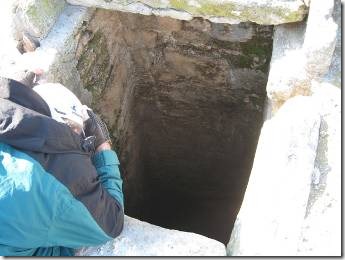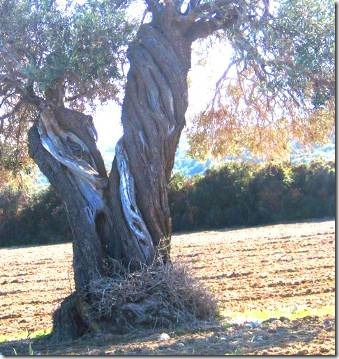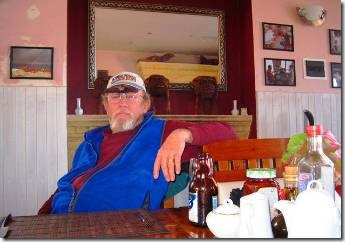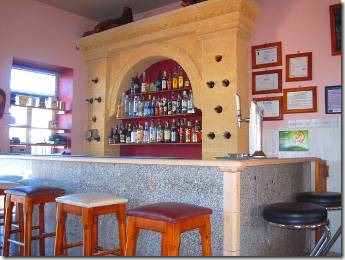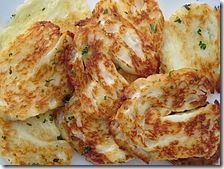Just came back from the marina office where we were interviewed by the census takers. I asked the reason and they are attempting to learn about tourists as well as count their own population. It took about 10 minutes because we had two forms and one translator. Now we’re back to boat chores which I don’t mind since we can’t leave the marina anyway until 6pm. By 6pm we’re bundled up in our stay on the boat and keep warm clothes so don’t go out anyway.
Ru
Sheep and Goats and Hellim or Halloumi Cheese
They look like the sheep in the Certa mattress commercial!
My walk Friday afternoon into Sipahi and the walk Randal and I did Saturday morning both involved herds of sheep and goats, which not only makes me think of yarn and knitting, but especially the wonderful white cheese I love. There is a cheese factory in Yenierenköy and I was finally able to find its website along with some information from a website about rural development in Europe.
“ Dairy In the Karpaz area there is only one modern private milk factory in Yenierenköy (Akgöl Dairy plant http://www.akgoldairies.com/) Actual amount of milk processed is around 20 tons/day (which is around 50% of the installed capacity). The dairy is oriented on one product hellim, which is 95% for export markets (particularly in the Middle East). The managers of the plant report that there is a potential to substantially increase exports of their product, even in the actual markets, allowing at least to use the installed capacity, and that the limiting factor is the insufficient milk
supply.”
http://www.tccruraldevelopment.eu/rdst/images/docs/ldskarpaz.pdf
Because North Cyprus isn’t recognized by most of the world, its products have been embargoed.
“European Union have put a ban on direct trading by the Turkish Cyprus. Such embargo has raised the cost of business and exports because the islanders have to trade through Turkey…..Dairy is another source of earning foreign exchange from export of cheese. Cyprus Cheese has high demand in the outside world. There are small manufacturing units in TRNC. The infra-structure development is quite impressive.” http://www.trncinfo.org/tanitma/en/index.asp?sayfa=haberdetay&newsid=902
The Akgöl Dairy’s website is quite interesting and it’s in English. They explain the different cheeses and how they are made. They also mentioned storing cheese in clay pots like the ones my yogurt came in. “Village Halloumi is still produced all around the island, stored either in traditional earthenware pots or, increasingly, in the refrigerator.” Maybe this is why the yogurt I bought came in the “earthenware pot” though Akgöl doesn’t list yogurt as one of their products. Judy on BeBe has a special water sealed ceramic pot for butter than makes refrigeration unnecessary.
My walk Friday afternoon was my usual up the hill into Sipahi towards the basilica. But now they have a ticket collector at the gate so I just walk past it. Luckily I made all of my visits in August when it was free. Instead I walked down the street of the home where I’d gotten help with the puppy that had found me.
Everyone’s second car is a tractor.
Back in our bike riding days we used to joke that our second car was a bicycle. But here lots of people farm so tractors are more necessary than bicycles. Actually we don’t see many bicycles on the road except those owned by cruisers.
Unpicked pomegranates left on the vine looked really pretty against the green grass and white window.
When we left Cyprus for the US our taxi driver told us we would return to a country that had turned green. Well, it’s not as green as Ireland, but there are many fields that are now green and the dirt is dark brown soil rather than dusty brown desert.
Shepherd and his flock of sheep.
He and I had an interesting conversation since he spoke about as much English as I do Turkish. I wanted to know if the sheep were for wool of food. I think we figured out they weren’t for food because I could mime eating, but the knitting mime didn’t quite work. His brother came along as well as the small boy who lived across from the basilica with his puppy. The older boy is in grade 10 and his younger brother in grade 4. They go to the school in Yenierenköy up the hill from the cheese factory.
I started back down the hill because by 4pm the sun starts to set and the temperature seems to drop 10 degrees. However, I couldn’t pass up the sound of sheep/goat bells in the distance so turned off the paved road onto a dirt road heading back into the hills. This truck pulled onto the dirt road shortly after I had and the passenger jumped out and started running back across the main road, I thought for maybe a missing sheep or two.
These sheep seemed to be heading to another pasture.
Actually it was a whole herd and they seemed to be aiming for me!
I just backed into some brush because they were coming quite fast and some were big, with horns! It’s hard to tell from this photo how surrounded I was. Once I decided they wouldn’t trample over me, I worried that I’d scare them away from where they were supposed to be going. But these herds of sheep are well trained and the young man was able to get what looked like about 60 or 70 sheep to do exactly what he wanted and go where he wanted them to go. I guess that’s why the expression about following along like sheep arose. They do follow. But so do goats and lots of other animals.
Sunday, December 4th, is census day in North Cyprus and everyone has to stay in the marina close to their boat. Apparently everyone on the island is counted and not just those who actually live here. Knowing we couldn’t go off for a walk Sunday, I wanted to do a longer one on Saturday. So Randal and I biked down to Deks, parked the motorbike, and did the loop hike we’d done the prior Saturday past the icon church near the stone statues. It takes about 2 hours and then it’s time for lunch at Deks!
Not long after we started a man drove by in a pickup truck. He was wearing a NY Yankees hat! He waved and that was that. Later we would see him again. As we neared the church we heard the sound of animal bells. I say animal because it could be sheep, goats, or possibly cows. This time it turned out to be a herd of goats!
A multicolored herd of goats.
They pretty much ignored us, followed the other goats and the man on the mule.
Still wearing his NY hat but this time riding a mule.
He led the way and the goats followed herded along by the dogs and the sound of the man’s occasional calls.
The goats passed just by the church ruins but none stopped to go in.
We didn’t take the same route down the mountain as the goats, but occasionally we would get to the same point at the same time. I was worried about one silly, tiny white goat that kept lagging behind and then bleating forlornly for the herd. I wanted to “help” it but Randal told me to leave it alone and not confuse it or have someone think I was rustling tiny goats. Eventually it found some other stragglers and I guess they all got to where they were going.
If this was an old well, it was dry now. I threw down a stone and there was no splash.
An Arthur Rackham fairy tale tree.
http://www.library.pitt.edu/libraries/is/enroom/illustrators/rackham.htm if you want to see why I say that.
Randal with his Efes beer and my pot of English tea while we wait for our usual lunch of meze.
We are always “starving” when we start lunch and too full by the end having eaten every bit plus I drank the entire pot of tea! There is humus, white cheese, thick yogurt, olives, pickled beets, sun-dried tomatoes and bread. Yum. We have lots of the same stuff on the boat, but it always tastes better at Deks served in a collection of small white bowls.
The “bar” part of Deks Restaurant and Bar.
Cypriot halloumi (pronounced "ha-loo-mee").
Grilled Halloumi cheese
Halloumi cheese originated in Cyprus[4] and was initially made during the Medieval Byzantine period,[8] subsequently gaining popularity throughout the rest of the Middle East region.
The cheese is white, with a distinctive layered texture, similar to mozzarella and has a salty flavour. It is stored in its natural juices with salt-water and can keep for up to a year if frozen below −18 °C (0 °F) and defrosted to +4 °C (39 °F) for sale. It is often garnished with mint to add to the taste. Traditionally, the mint leaves were used as a preservative, this practice arising from the serendipitous discovery that Halloumi kept better and was fresher and more flavourful when wrapped with mint leaves. In accordance with this tradition, many packages of halloumi contain fragments of mint leaves on the surface of the cheese.
The cheese is much used in cooking and can be fried until brown without melting, owing to its higher-than-normal melting point. This makes it an excellent cheese for frying or grilling (e.g. in saganaki) or fried and served with vegetables, as an ingredient in salads. Cypriots like eating halloumi with watermelon in the warm months, and as halloumi and lountza – a combination of halloumi cheese and either a slice of smoked pork, or a soft lamb sausage.[citation needed]
The resistance to melting comes from the fresh curd being heated before being shaped and placed in brine.[9] Traditional halloumi is a semicircular shape, about the size of a large wallet, weighing 220-270 g. The fat content is approximately 25% wet weight, 47% dry weight with about 17% protein. Its firm texture when cooked causes it to squeak on the teeth when being chewed.
Traditional halloumi is made from unpasteurised sheep and goats milk. Many people also like halloumi that has been aged; kept in its own brine, it is much drier, much stronger and much saltier. This cheese is very different from the milder halloumi that Western chefs use as an ingredient.
Although it is made worldwide and is of rather disputed origin due to the mixed cultures in the Levant and East Mediterranean, halloumi is currently registered as a protected Cypriot product within the US (since the 1990s) but not the EU. The delay in registering the name halloumi with the EU has been largely due to a conflict between dairy producers and sheep and goat farmers as to whether registered halloumi will contain cow’s milk or not and if so, at what ratios with sheep and goat’s milk.[10][11] If it is registered as a PDO (Protected designation of origin) it will receive similar status as 600 or so other agricultural products such as feta and parmesan cheese.

